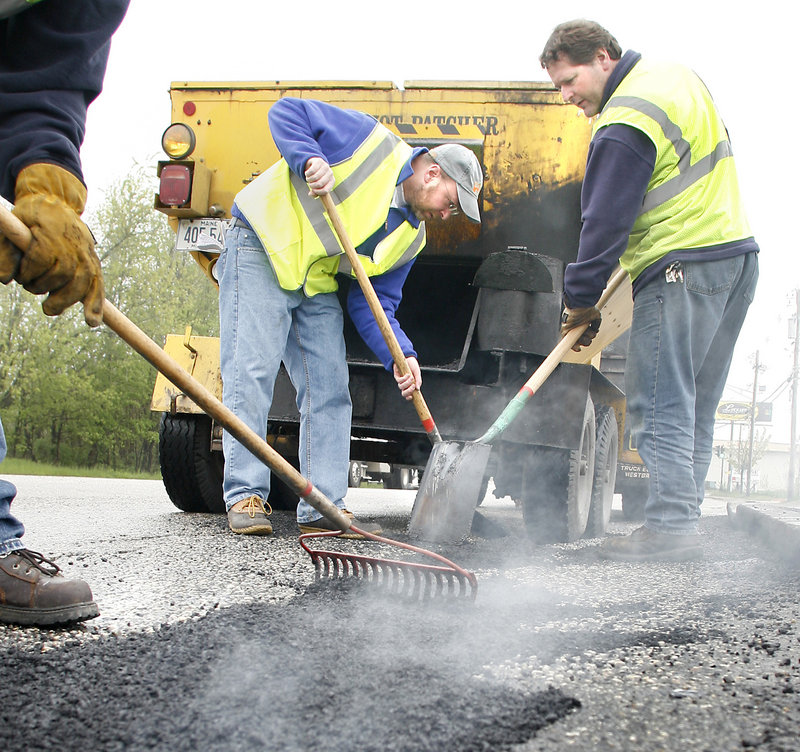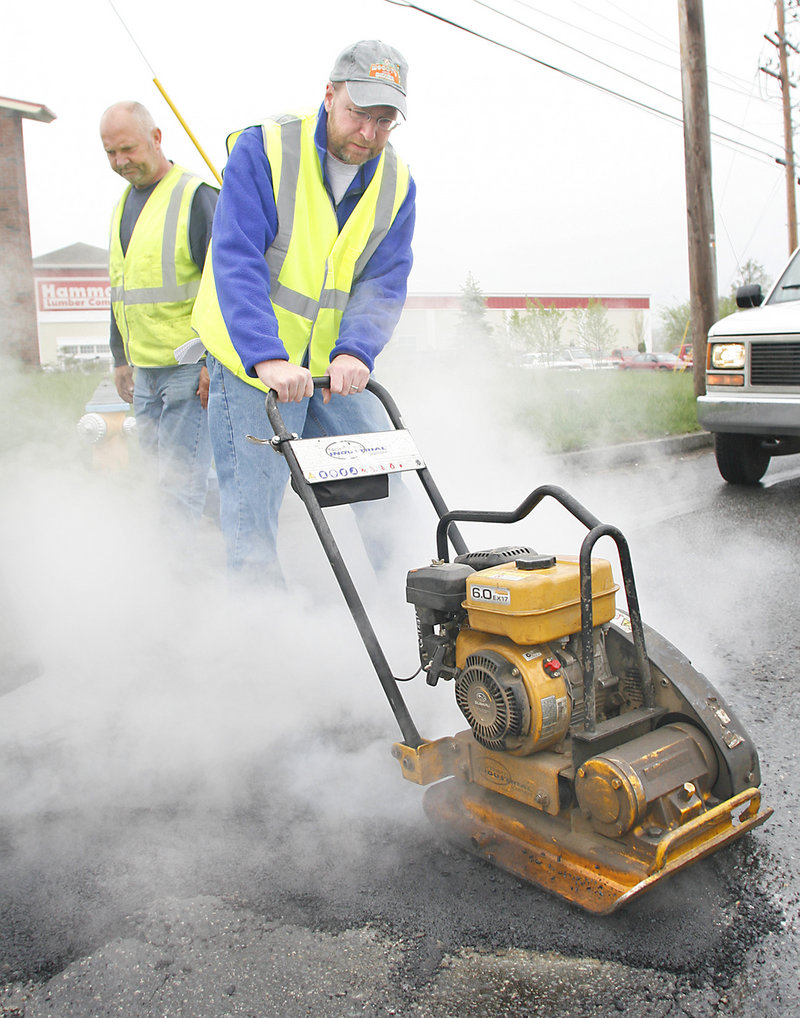PORTLAND – Before heading out with a Public Services Department crew to fill potholes last week, I was told the “hot patch” pavement mix they use is heated to 360 degrees.
So as I drove with Kim Dolbow toward a veritable minefield of potholes on Riverside Street, I asked him whether avoiding contact with the hot paving material was the primary safety concern on the job.
“Nah, it’s trying to not get hit by a car,” said Dolbow, 57, a 37-year veteran of the department. “We have to stop wherever the hole is, but people don’t see us. A lot of drivers only know one lane, and they don’t want to change lanes.”
Dolbow then told me that when we get out of the truck to fill a pothole, he wanted me to stay on the sidewalk side, not the speeding traffic side. I did not argue.
Because the paving material is carried by shovel to the potholes, Dolbow had to park his truck — with its trailer full of hot patch — pretty close to the holes. Because the traffic on Riverside, Warren Avenue and Forest Avenue was so heavy, we had another truck with us. That truck, manned by Bruce Hebert and Brian Parent, is what’s known in road work parlance as a “chase truck.” That truck parks behind the crew doing the patch work, with its lights flashing, to stop drivers from getting too close to the workers.
“If that truck wasn’t behind us, drivers wouldn’t turn out of this lane until the last minute,” said Dolbow.
Dolbow wishes people were a little more understanding of pothole crews. After all, he says, workers are filling potholes to make roads safer for drivers. But he understands that people have places to go, so he and his co-workers fill the holes as quickly as possible.
For one small individual pothole on Riverside Street near Forest Avenue — maybe a couple of feet in diameter — Dolbow and I jumped out of the truck, he threw two or three shovelfuls of hot patch into the hole, and I tamped it with a cast-iron tamping tool — a big wooden handle with a flat square of iron on the end. We were back in the truck in about one minute.
But it wasn’t long before we got to a giant rash of potholes on Riverside Street near Warren Avenue. There were dozens, and some were basically trenches, 10 feet long. For this area, all four of us got out of the trucks and began working.
I grabbed a long-handled shovel and stuck it into the open door on the back of the hot patch trailer. Then I carried the sizzling load of paving material about 10 feet to a water-filled pothole (it had been raining all week) and dumped it in. The cloud of steam that exploded from the pothole made it hard for me to see for several seconds. I heard a couple of cars beeping at us during this time, which made me a little nervous.
After we filled the giant trench-like hole, Dolbow had me spritz some oil on it. This way we could use the gas-powered compactor to tamp down the material. For the large holes, the compactor is best, and it works best if the paving material is made slick with oil.
The compactor looks like a lawn mower on skis, but weighs about 10 times as much. On the bottom it has a big steel plate that vibrates up and down as it moves across the paving material.
Plus it has no reverse gear. So once Dolbow started it up, I had to steer it over the pothole in one direction, in a circle. Once in a while I had to summon my strength to pull it in a different direction. When I was done, my hands continued to vibrate for several minutes.
“It’s pretty physical work, guys get sore backs, sore shoulders,” said Hebert, a 24-year-veteran of the job.
While we worked on Riverside, I noticed clumps of black paving material lining the curbs.
Dolbow and the others told me that was the remnants of the “cold patch” material they put down in this area this past winter. When the weather is cold, the hot patch material can’t be used and isn’t available. So the only temporary way to patch a pothole in winter is to use cold patch.
Trouble is, cold patch material is weaker, so heavy rains or a well-placed truck tire can knock it out. Hebert said that at some point, when there weren’t so many potholes to fill, a crew would come back, scrape up all the cold patch material and dispose of it.
The hot paving material, on the other hand, should last a year or so. But the only way to truly and permanently fix a pothole is to reconstruct that portion of the road, I was told. And some of that will be done this summer, but it’s larger scale work that has to be put out to bid.
So for now, crews of Public Services Department workers will be out all day long patching potholes. I was told that during the winter, crews sometimes had as many as 500 work orders — or complaints — for potholes. And there is a time element involved, because if someone reports hitting a pothole, city crews have to fix it within 24 hours.
But they can’t spend all their time fixing potholes, since Public Services maintenance workers are also responsible for mowing grass on city-owned park land, maintaining sidewalks, snow removal and myriad other tasks.
“I like being outside and I like the fact that we do different things,” said Dolbow, grabbing a shovel off his truck to get more paving material. “But safety is number one. To me, if we all get home safe tonight, it’s been a good day.”
Staff Writer Ray Routhier can be contacted at 791-6454 or at:
rrouthier@pressherald.com
Send questions/comments to the editors.




